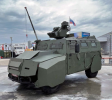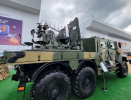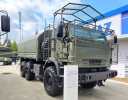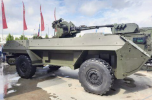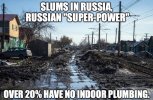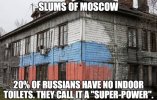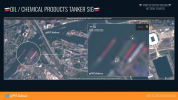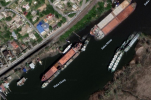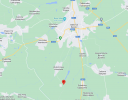Antares
Respected Leader
Tatarigami_UA pyrkinyt arvioimaan satelliittikuvien avulla 103. armored repair plant pajan kyvystä suoriutua heille annetusta tehtävästä (800 kpl modernisoituja panssarivaunuja kolmen vuoden aikana, ei pelkästään T-62M ja T-62MV modernisointia vaan myös T-72 vaunuja - mutta isoksi osaksi T-62 perheen vaunuja kuitenkin).
Ketjussa on paljon kuvia, liian monta yhdessä viestissä lainattavaksi joten lainaan pelkän tekstin spoilerin taakse (jätin muutaman kuvan muodon vuoksi):
-
Hänen arvionsa lopputulema:
Considering Gurulev's prior remarks, coupled with accessible satellite imagery illustrating a two-month gap and internal facility videos, my assessment suggests a production range spanning from a conservative estimate of 7 tanks per month to a more generous estimate of 17.
These estimates, 7 to 17 tanks per month, provide a general overview of production scale, with a range of uncertainties. This falls below the Russian target of 16 tanks per month, translating to 576 tanks in three years, fewer than the stipulated 800.
It's important to note this facility isn't the sole repair/modernization center in Russia. There other factories and BTRZ plants (22, 61, 81, 103, 144, 153), albeit it appears that their production scale could be even lower.
Eli arvioi kuukausikapasiteetin olevan jotain väliltä 7 - 17 panssarivaunua per kuukausi. Sanoo "7 vaunua per kuukausi" arviota konservatiiviseksi, kun taas "17 vaunua per kuukausi" on avokätisempi arvio.
Arviossa on epävarmuustekijöitä, mutta 16 vaunua per kuukausi keskiarvolla kolmen vuoden saldo olisi 576 modernisoitua panssarivaunua, ei tehtäväksi annettu 800 kpl (joka vaatisi 22,2 kpl keskiarvoista kuukausitahtia). Vastaavasti se tarkoittaisi, että yhden vuoden aikana he kykenisivät modernisoimaan 192 kpl panssarivaunuja (keskiarvoisesti).
Venäjällä on useita "armored repair plant" pajoja, mutta ne keskittyvät myös muun kaluston aktivointiin ja modernisointiin, ei pelkästään panssarivaunuihin. Tatarigami_UA sivuaa näitä lyhyesti, todeten että niiden kapasiteetti VOI OLLA pienempi kuin tässä tarkastellussa 103. armored repair plant tapauksessa. Armored repair plant pajojen lisäksi ovat tietysti Uralvagonzavod, Omsktransmash ja Kurganmashzavod - hän ei kommentoi näitä.
-
MUOKKAUS: lisätään muistutukseksi tämä vanha БТРЗ № 61 eli 61st armored repair plant tehtaan seinältä otettu kuva, jossa näkyy kyseisen pajan vuosituotanto (tosin viimeinen vuosi on 2015). Uskoakseni tässä on pelkästään vanhan kaluston peruskorjausta, jonka myötä ne on palautettu "uutta vastaavaan kuntoon" - mikä toki voi olla venyvä käsite, varsinkin 1990-luvulla ja 2000-luvun ensimmäisen vuosikymmenen aikana.
Below, an information board of one of the five regional plants with "production" (cars repaired with mileage reset)
(HUOM: tämä on БТРЗ № 61 eli 61st armored repair plant tehtaan seinältä otettu kuva)
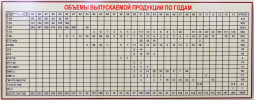
Koska tässä on melko sekalainen kattaus, ennen kuin "erikoistuivat" T-72 ja T-80 perheiden vaunujen kunnostamiseen vuodesta 2011 alkaen, päätin laskea taulukosta pelkkien "modernien panssarivaunujen" määrät per vuosi. HUOM: en pitäisi mahdottomana sellaistakaan ajatusta, että esim. T-72 vaunut olisivat käyneet ensin peruskorjattavana tällä pajalla, ennen kuin ne on viety UVZ:lle modernisoitavaksi T-72B3 vaunuiksi. Tälle ei ole todisteita, mutta ajankohta sopisi hyvin koska T-72B3 modernisointiohjelma lähti kunnolla käyntiin vuonna 2012. Toki T-72BA modernisointia tehtiin aikavälillä 2000-2011, joten tältä osin tämä teoria ei täsmää alla olevien numeroiden kanssa. Lisäksi muistettava: ryssällä on myös tarve ylläpitää varastovaunuja tietty määrä, jokainen ei mene modernisoitavaksi (tähän ei ole varaa, siksi tarvitaan myös heikomman suorituskyvyn modernisoimattomia vaunuja - jo ennen Ukrainaan hyökkäystä).
Huomaa myös, että kuvasta paljastui muutama laskuvirhe, tai vähintään erikoinen poikkeus vuosikohtaisten numeroiden ja merkittyjen summien osalta (vertaa alla olevan taulukon rivien ja sarakkeiden summia ja niiden viereen merkittyjä "kuvan numerot" tietoja):
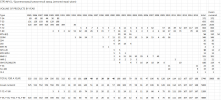
Ketjussa on paljon kuvia, liian monta yhdessä viestissä lainattavaksi joten lainaan pelkän tekstin spoilerin taakse (jätin muutaman kuvan muodon vuoksi):
During times of war, determining the enemy's production capacity, often shrouded in secrecy, is a challenging task. As promised, today's focus involves employing satellite imagery analysis and OSINT to approximate production numbers at BTRZ-103 (Armored Repair Plant).
Katso liite: 82396
Before delving into specifics, let's clarify the role of BTRZ-103. Situated near Chita in Russia's East, this plant specializes in repairing and modernizing vehicles. The facility's current emphasis centers on T-62, BRDM, and BMP vehicle modernizations.
T-62 tanks undergo complete disassembly, with engine replacements, rust removal, installation of new wiring, fire control, sight systems, and upgraded armor with ERA blocks. A contract was awarded to BTRZ-103 for the modernization of 800 T-62 tanks over a 3-year span.
Based on satellite imagery from mid-April and late June, we observe 11 and 17 recently modernized tanks respectively, evident by distinct appearances and darker paint, a distinguishable detail from faded paint on other vehicles.
Katso liite: 82398
Significant portions of the scrapyard appear relatively untouched, implying many vehicles are in poor condition, designated for last-resort storage or deemed irreparable, corroborated by recent satellite imagery and photos from nearly a decade ago.
Katso liite: 82399
Despite relocation of vehicles to the facility's interior, not all will undergo modernization, as interviews with factory workers reveal assessment for repair feasibility or potential use as parts.
Katso liite: 82400
Considering Gurulev's prior remarks, coupled with accessible satellite imagery illustrating a two-month gap and internal facility videos, my assessment suggests a production range spanning from a conservative estimate of 7 tanks per month to a more generous estimate of 17.
These estimates, 7 to 17 tanks per month, provide a general overview of production scale, with a range of uncertainties. This falls below the Russian target of 16 tanks per month, translating to 576 tanks in three years, fewer than the stipulated 800.
It's important to note this facility isn't the sole repair/modernization center in Russia. There other factories and BTRZ plants (22, 61, 81, 103, 144, 153), albeit it appears that their production scale could be even lower.
Despite ERA blocks, the T-62's armor remains vulnerable to contemporary anti-tank weaponry. Nevertheless, they retain utility in offering indirect fire support and presenting a formidable challenge to mobile forces attempting to advance or flank the secondary defense line.
It's worth noting that our destruction of russian tanks currently surpasses their repair and production capabilities. Nonetheless, this threat persists for our units, particularly those with limited resources. Maintaining assistance to Ukraine is vital to keep this trend
Katso liite: 82396
Before delving into specifics, let's clarify the role of BTRZ-103. Situated near Chita in Russia's East, this plant specializes in repairing and modernizing vehicles. The facility's current emphasis centers on T-62, BRDM, and BMP vehicle modernizations.
T-62 tanks undergo complete disassembly, with engine replacements, rust removal, installation of new wiring, fire control, sight systems, and upgraded armor with ERA blocks. A contract was awarded to BTRZ-103 for the modernization of 800 T-62 tanks over a 3-year span.
Based on satellite imagery from mid-April and late June, we observe 11 and 17 recently modernized tanks respectively, evident by distinct appearances and darker paint, a distinguishable detail from faded paint on other vehicles.
Katso liite: 82398
Significant portions of the scrapyard appear relatively untouched, implying many vehicles are in poor condition, designated for last-resort storage or deemed irreparable, corroborated by recent satellite imagery and photos from nearly a decade ago.
Katso liite: 82399
Despite relocation of vehicles to the facility's interior, not all will undergo modernization, as interviews with factory workers reveal assessment for repair feasibility or potential use as parts.
Katso liite: 82400
Considering Gurulev's prior remarks, coupled with accessible satellite imagery illustrating a two-month gap and internal facility videos, my assessment suggests a production range spanning from a conservative estimate of 7 tanks per month to a more generous estimate of 17.
These estimates, 7 to 17 tanks per month, provide a general overview of production scale, with a range of uncertainties. This falls below the Russian target of 16 tanks per month, translating to 576 tanks in three years, fewer than the stipulated 800.
It's important to note this facility isn't the sole repair/modernization center in Russia. There other factories and BTRZ plants (22, 61, 81, 103, 144, 153), albeit it appears that their production scale could be even lower.
Despite ERA blocks, the T-62's armor remains vulnerable to contemporary anti-tank weaponry. Nevertheless, they retain utility in offering indirect fire support and presenting a formidable challenge to mobile forces attempting to advance or flank the secondary defense line.
It's worth noting that our destruction of russian tanks currently surpasses their repair and production capabilities. Nonetheless, this threat persists for our units, particularly those with limited resources. Maintaining assistance to Ukraine is vital to keep this trend
-
Hänen arvionsa lopputulema:
Considering Gurulev's prior remarks, coupled with accessible satellite imagery illustrating a two-month gap and internal facility videos, my assessment suggests a production range spanning from a conservative estimate of 7 tanks per month to a more generous estimate of 17.
These estimates, 7 to 17 tanks per month, provide a general overview of production scale, with a range of uncertainties. This falls below the Russian target of 16 tanks per month, translating to 576 tanks in three years, fewer than the stipulated 800.
It's important to note this facility isn't the sole repair/modernization center in Russia. There other factories and BTRZ plants (22, 61, 81, 103, 144, 153), albeit it appears that their production scale could be even lower.
Eli arvioi kuukausikapasiteetin olevan jotain väliltä 7 - 17 panssarivaunua per kuukausi. Sanoo "7 vaunua per kuukausi" arviota konservatiiviseksi, kun taas "17 vaunua per kuukausi" on avokätisempi arvio.
Arviossa on epävarmuustekijöitä, mutta 16 vaunua per kuukausi keskiarvolla kolmen vuoden saldo olisi 576 modernisoitua panssarivaunua, ei tehtäväksi annettu 800 kpl (joka vaatisi 22,2 kpl keskiarvoista kuukausitahtia). Vastaavasti se tarkoittaisi, että yhden vuoden aikana he kykenisivät modernisoimaan 192 kpl panssarivaunuja (keskiarvoisesti).
Venäjällä on useita "armored repair plant" pajoja, mutta ne keskittyvät myös muun kaluston aktivointiin ja modernisointiin, ei pelkästään panssarivaunuihin. Tatarigami_UA sivuaa näitä lyhyesti, todeten että niiden kapasiteetti VOI OLLA pienempi kuin tässä tarkastellussa 103. armored repair plant tapauksessa. Armored repair plant pajojen lisäksi ovat tietysti Uralvagonzavod, Omsktransmash ja Kurganmashzavod - hän ei kommentoi näitä.
-
MUOKKAUS: lisätään muistutukseksi tämä vanha БТРЗ № 61 eli 61st armored repair plant tehtaan seinältä otettu kuva, jossa näkyy kyseisen pajan vuosituotanto (tosin viimeinen vuosi on 2015). Uskoakseni tässä on pelkästään vanhan kaluston peruskorjausta, jonka myötä ne on palautettu "uutta vastaavaan kuntoon" - mikä toki voi olla venyvä käsite, varsinkin 1990-luvulla ja 2000-luvun ensimmäisen vuosikymmenen aikana.
Below, an information board of one of the five regional plants with "production" (cars repaired with mileage reset)
(HUOM: tämä on БТРЗ № 61 eli 61st armored repair plant tehtaan seinältä otettu kuva)

Koska tässä on melko sekalainen kattaus, ennen kuin "erikoistuivat" T-72 ja T-80 perheiden vaunujen kunnostamiseen vuodesta 2011 alkaen, päätin laskea taulukosta pelkkien "modernien panssarivaunujen" määrät per vuosi. HUOM: en pitäisi mahdottomana sellaistakaan ajatusta, että esim. T-72 vaunut olisivat käyneet ensin peruskorjattavana tällä pajalla, ennen kuin ne on viety UVZ:lle modernisoitavaksi T-72B3 vaunuiksi. Tälle ei ole todisteita, mutta ajankohta sopisi hyvin koska T-72B3 modernisointiohjelma lähti kunnolla käyntiin vuonna 2012. Toki T-72BA modernisointia tehtiin aikavälillä 2000-2011, joten tältä osin tämä teoria ei täsmää alla olevien numeroiden kanssa. Lisäksi muistettava: ryssällä on myös tarve ylläpitää varastovaunuja tietty määrä, jokainen ei mene modernisoitavaksi (tähän ei ole varaa, siksi tarvitaan myös heikomman suorituskyvyn modernisoimattomia vaunuja - jo ennen Ukrainaan hyökkäystä).
Huomaa myös, että kuvasta paljastui muutama laskuvirhe, tai vähintään erikoinen poikkeus vuosikohtaisten numeroiden ja merkittyjen summien osalta (vertaa alla olevan taulukon rivien ja sarakkeiden summia ja niiden viereen merkittyjä "kuvan numerot" tietoja):

Viimeksi muokattu:

 For the 3rd day, the forces of the 3rd Special Operations Brigade have been holding the defense, the 20th MSD of the 8th Army of the RF Armed Forces has pulled up many T-90M tanks in that direction. The purpose of the counter-offensive is to drive the Armed Forces of Ukraine beyond the SD channel and out of Klishchiivka.
For the 3rd day, the forces of the 3rd Special Operations Brigade have been holding the defense, the 20th MSD of the 8th Army of the RF Armed Forces has pulled up many T-90M tanks in that direction. The purpose of the counter-offensive is to drive the Armed Forces of Ukraine beyond the SD channel and out of Klishchiivka.
